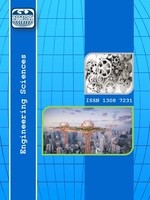DECISION-MAKING PROCESS TECHNIQUES USED IN THE OPTIMIZATION OF CONSTRUCTION PROJECTS
Optimization, Construction Project, Decision-Making, Construction, MATLAB
___
- [1] Bromilow, F.J., (1969). Contract Time Performance Expectation and the Reality. Building Forum, 1(3):70-80.
- [2] Le-Hoai, L. and Lee, Y.D., (2009). Time-Cost Relationships of Building Construction Project in Korea. Facilities, 27(13/14):549-559.
- [3] Parveen, S. and Saha, S.K. (2012). GA Based Multi-Objective Time-Cost Optimization in a Project with Resources Consideration. International Journal of Modern Engineering Research (IJMER), 2(6):4352-4359.
- [4] Rao, R.V., Savsani, V.J., and Vakharia, D.P., (2011). Teaching-Learning Based Optimization: A Novel Method for Constrained Mechanical Design Optimization Problems. Computer-Aided Design, 4:303-315.
- [5] Dede, T., (2014). Application of Teaching-Learning-Based-Optimization Algorithm for the Discrete Optimization of Truss Structures. KSCE Journal of Civil Engineering, 18(6):1759-1767.
- [6] Zheng, D.X.M., Thomas, N.S., and Kumaraswamy, M.M., (2005). Applying Pareto Ranking and Niche Formation to Genetic Algorithm-Based Multiobjective Time–Cost Optimization. J.Construction. Eng. Manage., 131(1):81-91.
- [7] Afshar, A., Kaveh, A., Kasaeian, A., and Shoghli, O.R., (2007). Modified Adaptive Weighting Method for Time-Cost Trade-off Problem based on Ant Colony Optimization. Proceedings of 3rd National Congress on Civil Engineering, 1-9.
- [8] Deb, K., (2002). A Fast and Elitist Multiobjective Genetic Algorithm: Nsga-Ii. IEEE Transactions on Evolutionary Computation, 6(2):182-197.
- [9] Zheng, D.X.M., Ng, S.T., and Kumaraswamy, M.M., (2004). Applying a Genetic Algorithm-Based Multiobjective Approach for Time-cost Optimization. Journal of Construction Engineering and Management, 130(2):168-176.
- [10] Gen, M. and Cheng, R., (2000). Genetic Algorithms & Engineering Optimization. Wiley-Interscience, New York.
- Başlangıç: 2009
- Yayıncı: E-Journal of New World Sciences Academy
DESTEK VEKTÖR MAKİNELERİ KULLANARAK YÜZ TANIMA UYGULAMASI GELİŞTİRİLMESİ
Nesrin AYDIN ATASOY, Derya TABAK
Osman Tuğrul BAKİ, Egemen ARAS
FARKLI İKLİMSEL BÖLGELERDE BULUNAN BİNALARDA YAPILAN YALITIMIN TERMAL VE EKONOMİK ANALİZİ
Ahmet Serhan Canbolat, Ömer Kaynaklı, Burak Türkan, Akın Burak Etemoğlu, Recep Yamankaradeniz
Veysel GÖKÇEK, Leyla TAVACIOĞLU
MUDURNU ÇAYININ TAŞKIN KAPASİTESİNİN ARAŞTIRILMASI
DECISION-MAKING PROCESS TECHNIQUES USED IN THE OPTIMIZATION OF CONSTRUCTION PROJECTS
